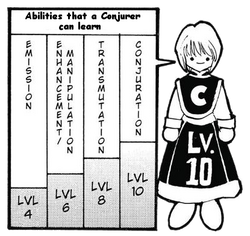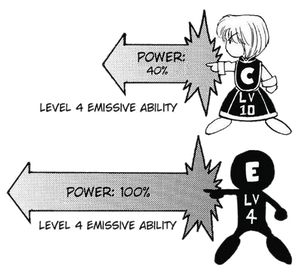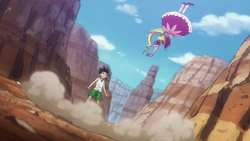Nen (念 or ネン, Nen—lit. "Sense";[1]* "Mind Force" in the Viz transl.)[2] is one of the defining features of the manga Hunter × Hunter by Yoshihiro Togashi. It is a technique that allows a living being to use and manipulate their own life energy (known as aura).[3] The term "Nen" can also be used in conversation to refer to aura. A person capable of utilizing Nen is colloquially referred to as a "Nen user" (
Nen and Aura
Aura Nodes and Awakening
Nen teaches one to control their own aura flow and utilize the energy
Aura (オーラ, Ōra) is the life energy produced by all living bodies vital for survival. Aura from all parts of the body has a tendency to flow together, producing one mass of energy. This happens without the individual's awareness, typically resulting in a slow leak of aura continually escaping the body[3] and stemming up and off the top of the head.[7] The pores or points on the body from which aura flows out from are called "Aura Nodes" (
Only someone whose Aura Nodes located in the eyes are opened can see aura,[8] whose normal leakage looks similar to water vapor from a kettle. Nonetheless, sensitive individuals can feel its presence without being aware of its existence. It has been described as feeling like a warm, viscous fluid at rest,[8] whereas powerful, refined auras produce a sensation that feels akin to needles pricking into the skin.[11] Hostile aura generates extremely unpleasant sensations, which can cause a non-user to halt in their tracks and be unable to walk towards the source as if a wall had been erected in front of them.[8] Since every living being emits aura subconsciously, learning to sense aura is a useful skill for those tracking living things or hunting non-living things infused with aura. An experienced user of Nen can judge the location and relative strength of their opponents through reading the output of their aura.[12] On the other hand, skilled Nen users can also regulate the flow of their aura so they appear to be beginners or regular individuals.[7]
Learning Nen and Initiation
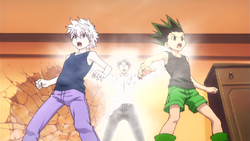
Wing initiating Gon and Killua to Nen
A student learning Nen trains to manually open and close their Aura Nodes so that they can control the flow of their aura. One typically learns this process slowly and gradually through meditation. There is a second method, colloquially called Initiation (
Initiation via physically attacking another is common practice at the Heavens Arena when a non-user reaches the 200th floor and typically results in injury, permanent disability, or even death.[8] Nonetheless, this is by no means the only way to force or, more appropriately, semi-force, the Aura Nodes open: the same result can be achieved through "indirect attacks", non-violent or even beneficial uses of aura on a non-user, such as through healing, lending, or absolutely first class Manipulation abilities.[14] Experienced Nen users can open a student's Aura Nodes simply by performing Hatsu on them.[8]
A state of half-awakening exists in which an individual may be able to control their aura to a certain degree and release a larger amount than a normal person, but still have some of their Aura Nodes closed, which may result in their being unable to see aura. This state can be found in some victims of Manipulation Nen as well as in the bodyguards of Halkenburg Hui Guo Rou, who reached it through the latter's Guardian Spirit Beast.[7]
Progression and Potential
While all living things posses aura and all humans (as well as possibly beings of other species) are able to master Nen, some excel at its usage more than others. What exactly factors into potential is for the most part a mystery, but it appears to be predominantly a congenital factor, since statistical estimations about its rarity can be made and evidence points against it changing over the course of one's life. The rubric of "potential" or "talent" entails both the maximum degree of mastery that one could achieve and the speed of one's learning, which seem to be directly proportional: the faster one learns, the higher their upper ceiling is assumed to be.[5][15] It is important to note that learning rate can have multiple meanings: Gon Freecss took more time than Killua Zoldyck to control the flow of his aura,[16] but he was able to discover multiple Nen techniques on his own,[17][18] and his potential was never implied to be lower than Killua's. The circumstances of one's growth can also combine with one's talent to facilitate learning,[17] further highlighting that rate of progression should not be taken as a perfectly transparent indicator of one's maximum potential, although in general it can be considered fairly reliable. There is an introductory exercise that can reveal a person's talent,[19] but there are also Nen users with the ability to estimate another's potential at a glance.[20][21][22]
There might be anecdotal evidence in support of talent for Nen depending at least in part on genetics and/or family history, since the fathers of Gon and Killua, whose potential can be found only in one person out of 10,000,000,[5] are both vastly above-average Nen users, and Tserriednich Hui Guo Rou, who was called a genius,[23] descends from a lineage of hosts of parasitic Nen beasts and possibly Nen users.[24] On the other hand, body type and sex are unrelated to one's potential,[25] while it is possible, though not definitive, that age affects the speed of one's learning.[14][note 1]
Of course, potential alone does not ensure that one will grow into a powerful Nen user, with one's regimen of training being fundamental in this regard. Furthermore, talent does not guarantee that one will progress in all areas of Nen with the same ease, as the comparison between Gon and Killua revealed. One's growth can also be stunted by training the wrong Nen categories.[26][5][27]
Nen of the Flame
Nen of the Flame[note 2] (燃 or ネン, Nen—lit. "Burn"*; "Flame" in the Viz translation) is sometimes used in Shingen-ryu kung fu as a precursor to learning the actual Nen. They are mental exercises akin to meditation that strengthen one's force of will. Regular practice can smooth the flow of one's aura. The Four Exercises of Nen of the Flame are as follows:
- Ten (点, Ten; "Point"): Focus the mind, reflect upon the self and determine the goal.
- Zetsu (舌, Zetsu; "Tongue"): Put it into words.
- Ren (錬, Ren; "Temper"): Intensify your will.
- Hatsu (発, Hatsu; "Release"): Put it to action.[2]
Upon his introduction, Wing taught Killua and Gon the Nen of the Flame as a fake sense of Nen that focuses mostly on meditation and on one's self.[2] Not all steps of this method directly manipulate aura and most have no visible effect; however, after Gon was injured by Gido and forbidden to use Nen for two months to recover by Wing, both Gon and Killua practiced this method,[17] and in fact made it more natural for them to use regular Nen. Given that Nen is linked to emotions and mental state, this method can be particularly useful to train Nen without aura, although normal use of technique is usually preferred.[28]
Properties of Nen
Nen and Emotion
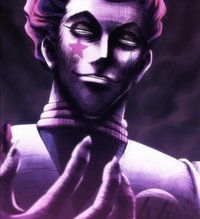
Togashi typically indicates this effect through his shading
Although the production of aura is unconscious and constant by all living beings, it is not only life energy. Aura carries with it the desires and emotions of the one who deploys it, which is what allows for Nen to have an incredible versatility to those who develop their skill at using it,[28] and also heavily influenced by mental condition and emotional state.[29] A basic application of this phenomenon is that one can channel their aggression or malice into their aura and deploy it towards another person (i.e. bloodlust). The antagonized will then be able to feel that bloodlust as if it were physically palpable; if unable to keep it from their own body by deploying their own Nen, he/she may be psychologically as well as physically harmed by it.[8] In certain instances, emotional factors may even lead to one exceeding their current ceiling. This could potentially prove advantageous, but in general using one's powers beyond their capacity entails a great risk and will ultimately cause strain.[29]
Post-Mortem Nen
The death of a Nen user does not necessarily result in the cessation of their abilities; on the contrary, it may cause pre-existing abilities to become even more powerful. The most common reason for this phenomenon to occur is the ability of the dying user while harboring a strong grudge will cause their Nen to seek out the object of their hatred and cling to it. This makes curse-type abilities much more difficult to remove, to the point that fewer than ten Exorcists in the whole world were deemed capable of lifting a curse left by the deceased.[30]
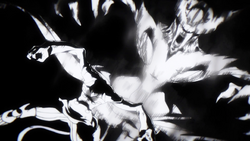
Terpsichora manipulates Neferpitou's headless corpse
It seems that other than hatred, any powerful enough emotion can result in post-mortem Nen: Neferpitou’s Terpsichora took control of their beheaded corpse out of loyalty to the King, even though the Royal Guard did not consciously perceive Gon as a threat due to believing him to have given up all of his potential to kill them.[31] Some Nen users go as far as to make their own death an activation requirement, which, despite their demise being only temporary and programmed, still grants their abilities greater power than normal.[32][33] Death can also cause Nen abilities to linger even if their doing so violates the conditions of other abilities: a notable example is The Sun and Moon, which remained in Chrollo’s book despite the creator passing away and, if applied to a conjured object, the object cannot be dispelled until the marks explode,[34] both of which are in explicit contradictions of conditions of the Spider’s Skill Hunter.[35]
Nen and Nature
Affinity with nature is connected to sensitivity for aura.[36] Wild animals are more perceptive in that regard than humans, and may learn Zetsu spontaneously.[37][38] However, only humans and certain Magical Beasts have displayed the ability to open their Aura Nodes and use Nen. Honing one's Nen abilities has the side effect of attuning them with nature to a greater degree, enabling the user to detect sounds, scents, and tracks non-users would miss, as well as to attract wildlife, this has led to the belief that good Hunters are well-liked by animals.[39]
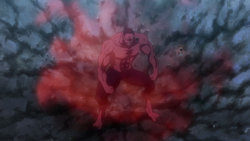
Youpi, who has no human genes, releasing his aura
After the Chimera Ant Queen who came to the Human World from the Dark Continent began to feed on humans, she spawned offspring with the innate ability to see aura, namely some Officers[40] and the Squadron Leaders.[40][41] The Royal Guards[41] and the King[42] were able to freely control their Aura Nodes and flow from birth. Menthuthuyoupi developed Nen abilities despite having no human genes, only those of a Magical Beast.[43] Nanika's wish-granting power is also known to work through aura.[44][45]
The Unknown
Though Nen is influenced by one's mental condition and emotional state, it is difficult to judge exactly to what extent these factors affect Nen. Biscuit Krueger became capable of altering her appearance without actively training for it, instead wishing for her body to change for years, which caused the changes to manifest little by little.[46] It is also unclear just how subjective and dependent upon one's capacity to assess risk certain ability conditions and Limitations are.
The mysterious inscription on Ging's metal box
Another mystery is the exact relation between Nen, the Divine Script and a seemingly different type of inscription. The Divine Script has the power to strengthen the Nen abilities of the one who drew it, provided it is charged with their aura and the user remains in its proximity;[47] the latter inscription was noted to have similar properties to Nen and the ability to reinforce whatever it is applied to, but cause it to break as soon as it comes in contact with aura.[48] Interestingly, it might have been used on a handcuff designed to restrain a Nen user.[49] Just like the Divine Script, this inscription appears to require aura to function.[28]
Nen in Society
Nen is a power unknown to the public at large, with only a minority of persons being capable of using it or even privy to its existence. Reports of incidents involving Nen are often misleading,[32] in large part probably because ignorance of its existence necessarily leads to incorrect assumptions.
Some non-users who hear of Nen believe it to be no more than a mental technique to gain a little boost in physical abilities by accessing the dormant power in one's body.[46] For their part, Nen users tend to avoid attracting too much attention in order to prevent society from spiraling into chaos.[6]
Nen and the State
It is unknown if leaders of countries or even of international entities (such as the V6) know about Nen. The high-ranking members of the Kakin Empire army are completely unaware of it,[50] although Prince Benjamin Hui Guo Rou, the Military Deputy Adviser, can use Nen and commands a squad of Nen users.[51] The King himself might be a Nen user, although awareness of the existence of Nen could be tied to the history of the family rather than be knowledge that is shared with the head of state because of their position. In the Republic of East Gorteau a small group of Nen-using soldiers guarded the royal palace.[42]
In ordinary circumstances Nen is not admissible as evidence in judicial proceedings.[7]
Nen and the Hunter Association
Acquiring control over one's aura flow is the final step to becoming a professional Hunter,[5] as per the second Hunter Bylaw.[52] According to Wing, this is because Hunters need to be deterrents for crime. However, since Nen could be extremely disruptive to society, it was deemed unsafe to include it as a publicly-known criterion and an official part of the Hunter Exam, and is therefore known within the Hunter Association as the "Secret Hunter Exam".[5] Accordingly, many high-profile jobs contracted to the Hunter Association list knowledge of Nen as a minimum requirement.[53] A licensed Hunter may not reveal the existence of Nen to those who do not know about it, although it is possible to relay this information in times of emergency.[54]
Many Hunters are proficient Nen users, with Isaac Netero, the 12th Chairman of the Hunter Association,[55] being revered as the world's most powerful Nen master in his prime.[56] Since mastery of Nen leads to attunement with nature,[36] this has led to the credence that good Hunters are well-liked by animals.[39]
Nen and the Heavens Arena
Curiously, Nen abilities are freely and regularly displayed in front of an audience at the Heavens Arena, and not only are they common knowledge from the 200th floor upward, fighters on that floor will brutally "initiate" anyone who reaches it without knowing Nen.[8] Hunters who participate in the matches and showcase Nen abilities seem to face no consequences despite the ban put in place by the Hunter Association, nor does it appear as though there are repercussions for openly mentioning the system.[57][note 3] On the other hand, the audience is in the vast majority of cases ignorant of Nen and confused by the supernatural powers they see. The commentators themselves appear to have no knowledge of Nen,[58] not even the ones overseeing Floor Master matches.[59]
Geniuses
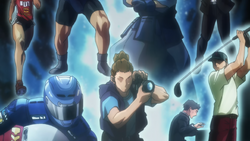
Some of the world's most famous and influential people have naturally learned Nen
Nen is like any other skill, in that there are those who can learn it faster than others. Some are able to discover and learn to manipulate their aura on their own without having formally learned it. These individuals are typically known as "geniuses", "psychics", or "superhumans" to the public. This can be anything from inadvertently being able to use the basic techniques of Nen[8] or unconsciously developing a unique Nen ability that can be used without really understanding how or why one is able to do so. Typically, geniuses of Nen are exceptional artisans in their own fields and their abilities are related to them.[60]
Notable geniuses within the series include:
- Neon Nostrade, the fortune-teller.
- Benny Delon, the mass-murderer and blacksmith.[60]
- Mukatolini, the lithographer.[61]
- Zepile, the counterfeit artist.[62]
- Komugi, the Gungi world champion.[63]
Four Major Principles
The four major principles of Nen
In order to fully grasp Nen, one must first learn the Four Major Principles (
These basic techniques become second-nature to those experienced in Nen. For example, a beginner must learn to use Ten and concentrate to maintain it; whereas someone with experience will practically always be in a state of Ten, even during sleep.[8]
Ten
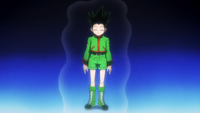
Gon using Ten
Once a person has opened their Aura Nodes, they must learn to keep their aura from leaking away from their body. Ten (纏, Ten; "Envelop"/"Shroud") is the process of keeping the nodes open, but also having aura flow through and around the body rather than away from it. Once maintained, it creates a shroud around the user that feels similar to standing in lukewarm, viscous fluid. Ten maintains youthful vigor and reduces one's aging, since the energy powering the body no longer leaks away; one can keep the body from breaking down and deter the aging process.[3] Ten is the most basic defense against emotional Nen attacks,[3] and it also offers limited protection against physical attacks,[2] but hardly any when said attacks are enhanced with aura.[17] Through frequent meditation and practice, one can improve the quality of their Ten and even maintain it in their sleep.[8] Once it has been learned, it will never be forgotten, much like cycling and swimming.[28] Despite being the most elementary technique of all, Ten is also one of the most important, since, together with Ren, it plays an instrumental role in determining the strength and smoothness of a Nen user's aura flow.[64][65]
Zetsu
Killua using Zetsu
While Ten allows a user to keep aura from leaking away from their body, Zetsu (絶, Zetsu; "Suppress"/"Null") stops the flow of aura from their body altogether. By closing all of their Aura Nodes, the user is able to halt all outflow of their aura like water from a valve, making their presence much harder or even impossible to sense.[3] Shutting off the nodes in their eyes prevents the user from being able to see aura,[66] but, since they are no longer surrounded by their own aura, they become more sensitive to the aura of others.[17] The enhancement in perception is such that Zetsu can counter In, although it is not advised to employ it this way.[28] This technique is thus doubly useful when tracking another person, as not only it will make it easier to follow them, it will also prevent other users of Nen from noticing their pursuer. However, there are other ways to perceive a person hiding with Zetsu: aside from the five senses being effective, particularly perceptive individuals are capable of detecting the gaze of another person, although they might not manage to discern the position and number of onlookers.[67] Furthermore, if Zetsu is utilized within a certain range from a Nen user, that Nen user might notice their presence disappearing, especially if the Zetsu user's aura is powerful.[68] Despite the technique not affecting vision directly, activating Zetsu in front of someone else will give them the impression the user has turned transparent.[67]
Zetsu can also be used to relieve fatigue, since it forces the body's external layer of aura to be fully contained within.[3] However, for the same reason it can be dangerous due to it leaving the body defenseless against any aura attack. Even a weak attack enhanced with Nen could do massive damage.[17] Since even the thin protection offered by Ten is gone, a Zetsu user is particularly susceptible also to hostile emotional attacks,[4] resulting in their mind becoming as vulnerable as their body.
Ren
Gon, Killua, and Zushi using Ren
Ren (練, Ren; "Refine"/"Enhance") focuses on outputting a larger amount of aura than Ten, projecting it outwards explosively.[3] This amplifies the user's physical strength and durability and provides a large pool of aura for any advanced techniques or individual skills they decide to use, albeit at the cost of expending said aura. One can train their Ren to extend its duration and increase the amount of aura at their disposal. It is said it takes one month to prolong one's Ren outside of combat by 10 minutes.[69] If Ten is considered purely defensive, Ren can be regarded as its offensive counterpart, although it also grants the user vastly enhanced defensive abilities.[70] With the right timing, Ten can be used to contain the aura produced with Ren.[71]
By tingeing one's Ren with hostility, a Nen user can exert what is colloquially referred to as "bloodlust". A prolonged emission of malicious Ren can induce uncontrollable dread in those who cannot use Nen, paralysis and, if contrasted without Ten, even death. On the other hand, a neutral Ren can rarely be felt by non-users.[3] Since Ren is a show of power, it can also intimidate other Nen users, as it offers an approximate measure of the user's raw strength;[72] in fact, by "show me your Ren", Hunters generally mean they want to see the fruits of one's training, such as a Nen ability, rather than their Ren per se.[73] In most cases, Ren reflects the user's hostility without their control, and it can even leave faint traces in the environment after the Nen user has left the scene.[74]
Hatsu
Wing using Hatsu
Hatsu (発, Hatsu; "Release"/"Act") is one's personal expression of Nen. Its qualities are influenced by but not restricted to the Nen user's natural Nen category, one of the six available, which is decided by nature and nurture. Hatsu is used to project one's aura to carry out a certain function, creating a special and unique paranormal ability[5] that is colloquially referred to as a "Nen ability" (
At first, Hatsu appears simply as a consequence of using Ren during Water Divination; however, it is more than a mere property of the latter, and it can be trained individually either through Water Divination itself, which however seems to only affect the user's natural category,[5] or by honing one's skills in a Nen category via specific exercises.[76] Once a certain level of skill has been attained, the student can attempt to create their personal Nen ability. Since they can have an immensely vast range of effects, Nen abilities may be recognized as any manifestation of one's Nen that cannot be ascribed to one of the basic or advanced techniques, although there are instances of Nen abilities being essentially applications of Ko (an advanced Nen technique which makes use of Hatsu) with special conditions or restrictions.[16] A good Nen ability reflects a person's own character, regardless of its complexity; one can never truly master Nen if they only copy someone else's abilities.[28]
Advanced Techniques
After acquiring a working command of the basics, a student is introduced to a series of advanced techniques that often combine and/or derive from the four Major Principles. These techniques expand the user's options in combat manifold, but they also consume more aura than the Four Major Principles.[18]
Gyo
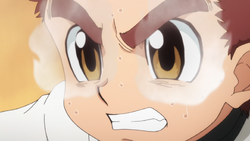
Zushi using Gyo
Gyo (凝, Gyō; "Focus") is an advanced application of Ren by which a Nen user concentrates a larger than normal portion of their aura into one specific body part. It increases the strength of that one body part, but leaves the rest of the body more vulnerable. Gyo is most often used in the eyes, allowing a Nen user to see aura and Nen constructs concealed with In[28] as well as traces of aura that so faint that they might go unnoticed otherwise.[60]
An alternative version of this technique gathers only the aura naturally leaking from the body instead of the greater amount produced with Ren. This application of Gyo can still increase the amount of aura in one select body part and thus its power, but the output is much lower than what is obtained through the regular technique.[77] It is unlikely this lower-consumption Gyo could counter In, since Wing had all his students perform Ren to do so.[28] However, it has proven to suffice to see thin layers of aura[60][64] as well as to perform Water Divination correctly.[78]
In

Uvogin trapped within Kurapika's chains, concealed from view through In
In (隱, In; "Conceal") is an advanced form of Zetsu used to render one's aura imperceptible, effectively concealing it. Unlike Zetsu, however, In does not stop the user's aura flow; instead, it hides it,[28] making it impossible to perceive with any of the five senses or extrasensorial perception. Hence, this technique is perfect for launching sneak attacks or laying traps, as it can conceal not only the user's presence,[79] but also Nen constructs generated with Transmutation,[28] or Conjuration.[79]
In can be countered by using Gyo in the eyes or through Zetsu.[28] When In conceals part[80] (or even all)[28] of the user's aura output, experienced Nen users can divine their opponent is using it if little or no aura can be felt from them in circumstances which would normally require it, such as during combat.[80]
En
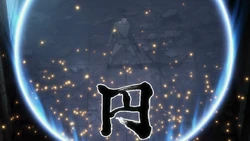
Nobunaga using En
En (円, En; "Circle") is an advanced application of Ten and Ren.[81] In Ren, aura usually envelops only a small amount of space around the user's body. En is when one extends their Ren so that their aura extends further than normal, then uses Ten at the same time to contain and give shape to that aura, normally a sphere. The minimum requirement is to extend one's aura to a radius of more than 2 meters (6.56168 feet) and hold it longer than 1 minute.[82] Someone using En can feel the shape and movement of anything within the area covered by their aura, with the degree of awareness and finesse depending on their level of skill.[81] Nen users can be told apart from regular people due to their stronger reaction to the En user's aura.[83] Zetsu can suppress a Nen user's response, making their position more difficult to pinpoint, but not their movements.[84]
Those who master En are typically able to extend it to a circle with a 50 meter (54 yard, 2 foot, 0.5052 inch) radius.[81] There are exceptions, however: Zeno Zoldyck, one of the most powerful assassins alive, is able to extend his En up to a radius of 300 meters (328.084 yards),[74] while the Chimera Ant Neferpitou has an irregularly shaped En and can extend a tendril up to 2 kilometers (1 mile, 427 yards, and 8.0064 inches).[84] The downside to this technique is that it is extremely tiring and draining for the Nen user to constantly deploy so much aura.[74] Furthermore, it is not always possible to distinguish between living beings and Nen constructs.[85]
Shu
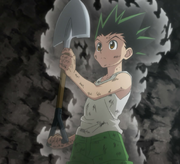
Gon using Shu
Shu (周, Shū; "Enfold") is an advanced application of Ten. Shu allows a user of Nen to enshroud an object with their aura, allowing them to use that object as an extension of their own body. For example, one could use Shu to extend their Ten around a weapon, which would strengthen and protect it.[18] Shu can be combined with other techniques, such as Ko.[76]
Ko
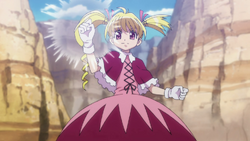
Biscuit using Ko
Ko (硬, Kō; "Temper") is a combination of Ten, Zetsu, Hatsu, Ren, and Gyo in which all of the user's aura is concentrated into one particular body part.[16] Gyo is utilized to focus aura on a part of the body, while Ten is used to prevent it from dispersing. Zetsu is used to completely stop the flow of Nen in all other parts of the body, increasing the output in the desired area. With Ren, the amount of aura is increased even further.[77] This makes that one body part extremely powerful, but at the cost of leaving the rest of the user's body completely unprotected. Due to the risk it carries, Ko is regarded as a purely offensive technique.[16] An incomplete version of this technique can be utilized without Ren, primarily to master the other steps before increasing the amount of aura to concentrate and contain.[77] Some Nen users, Enhancers in particular, employ Ko as a Nen ability by adding conditions to it.[86]
Ken
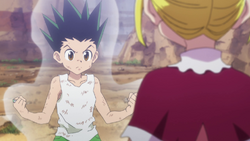
Gon using Ken
Ken (堅, Ken; "Fortify") is the advanced version of the basic Ren and Ten techniques. It is a primarily defensive technique where a Nen user maintains a state of Ren for a prolonged amount of time.[16] The amount of aura surrounding the user's body during Ken is about 10 times higher than during Ten.[87] Ken allows a Nen user to guard against attacks from any direction, but the large amount of aura produced makes it tiring to maintain. It is considered the best option to defend from Ko, despite not being as powerful as the latter on any given part of the body, as it protects all of it evenly.[16] When not immediately at risk of being struck with Ko, Ken is utilized when one wants to be cautious.[88] Some Nen users choose to expand its radius so as to sense incoming attacks they are unable to see,[89] as a miniature En of sorts. Sometimes Ken is colloquially called Ren owing to the similarities between the two techniques.[16]
Ryu
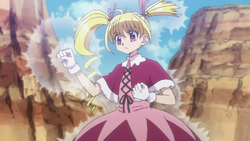
Biscuit using Ryu
Ryu (流, Ryū; "Flow") is the term for use of Gyo from a state of Ken to perform real-time offensive and defensive value adjustments. If Ko devolves 100% of one's aura to offense or, much more rarely, to defense, and Ken splits it evenly between the two, Ryu is redistributing one's aura according to any other percentage, for example by focusing 70% of one's aura in one fist as one is about to strike, or 80% in one's leg to block an incoming kick. It is utilized to damage a Ken user without leaving oneself as unprotected as during Ko, although the power of the technique is lower. Ryu is difficult to master, as it requires not only to control one's aura flow with great precision, but also to be able to estimate the amount of aura utilized by the opponent at a glance.[87] Even the technique is performed correctly, the movements of the aura flow risk giving away the user's next move if they are too slow.[88]
Nen and Individuality
There are six types of aura; every individual is born having one of these six different aura types. Upon learning one's own aura type, a student of Nen can set about learning to apply the technique in a unique way that suits their personality, which can develop into a unique skill.
There are numerical approximations to indicate just exactly how efficient one would be at using aura abilities that one is not born into. Starting at one's own aura type, one has the potential to be 100% efficient at using abilities based in that category alone.[90] Then looking at the category chart (see above), one has the potential to be 80% efficient at using aura types adjacent to one's primary type, 40% efficient at the opposite or farthest category, and 60% efficient in the two remaining categories. Specialization is typically unusable for non-Specialists because it is impossible to partially use; one either can or cannot use Specialist abilities. However, it is possible to turn into a Specialist later in life, with Conjurers and Manipulators having the highest chance of succeeding.[29][note 5]
Water Divination
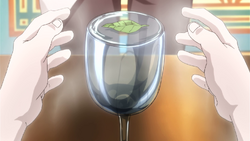
Water Divination
The most popular way (and the only sure-fire way seen in the series) of determining one's aura type is through Water Divination (
- If the volume of the water changes, then the user is an Enhancer.[5]
- If the taste of the water changes, then the user is a Transmuter.[5]
- If impurities appear in the water, then the user is a Conjurer.[5]
- If the color of the water changes, then the user is an Emitter.[5]
- If the leaf moves on the water's surface, then the user is a Manipulator.[5]
- If a completely different change appears, then the user is a Specialist.[5]
It is best to base a Nen ability on one's individual aura type. Though it is possible for one to develop abilities outside of his primary aura type, one is typically less proficient at using those abilities. By creating an ability that one isn't suited for, one risks stagnating their potential by overloading their capacity for using Nen[5] something Hisoka calls "Memory Overload".[26] However, there are examples of Nen masters, such as Biscuit Krueger and Isaac Netero, who have reached a high level in multiple categories and employ them consistently in their primary Nen abilities. In fact, according to Biscuit, training in all the accessible categories is the fastest and most efficient way to improve one's skills in one's own Nen type, with the additional benefit of increasing one's flexibility and proficiency in Nen in general. A bell curve is the ideal shape, with the time spent on each category decreasing the farther away said type is from the user's natural one.[92]
Hisoka's Personality Test
Hiso-Hiso's Aura-based Personality Analysis (ヒソヒソのオーラ別性格分析, HisoHiso no Ōra Betsu Seikaku Bunseki)[57] or Hisoka's Aura by Personality Diagnosis (
- Enhancers are simple and determined.[57] Most of them never lie, hide nothing, and are very straightforward in their actions or in their thinking. Their words and actions are often dominated by their feelings. They are generally very selfish and focused on their goals.[93] This is reflected in their Nen as Enhancers typically rely on simple and uncomplicated Nen abilities.
- Transmuters are whimsical, prone to deceit, and fickle.[57] Transmutation users have unique attitudes, and many are regarded as weirdos or tricksters. Often they put forth a facade while hiding the truer aspects of their personalities. Even when they don't hide their personalities they rarely reveal their true intentions.[93] Many Transmuters rely on techniques that give unique and unpredictable properties to their Nen that reflects their personalities.
- Emitters are impatient, not detail-oriented, short-tempered, and quick to react in a volatile manner.[94] They resemble the Enhancers in building their impulsivity, but the difference between them is that Emitters probably tend to calm down and forget easier.[93] Because of the nature of Emission, many Nen abilities created by Emitters are primarily long range.
- Conjurers are typically high-strung[94] or overly serious, stoic, and nervous. They are often on guard as to be cautious. They are very observant and logical, rarely falling into traps. Being able to analyze things calmly is the strength of Conjurers.[93] Many of the items that Conjurers create are often used by them in a very deliberate and practical, logical fashion.
- Manipulators are argumentative and logical. They advance at their own pace[94] and tend to want to keep their families and loved ones safe. On the other hand, when it comes to pursuing their own goals, they do not listen to what others might have to say about it.[93] While Manipulators often use techniques that allow them to control their opponents, some choose an inanimate medium to control.
- Specialists are independent and charismatic.[94][95] They won't say anything important on them and will refrain from being close friends, but, because of their natural charisma that draws others, they are always surrounded by many people.[93] Because Specialization is unique and can have many facets, most Specialists possess only one Nen ability.
Telltale Signs
Furykov was able to construct a system to identify Nen users[96] and their Nen types[19] through observation alone, which he claimed is the result of his experience. According to him, a way to differentiate between Nen users and non-users is that the outline of the former's iris, when looked at from the side, appears discontinuous.[96] One of the shortcomings of this method is that it cannot tell Nen users proper apart from individuals who have only "half awakened".[7]
A person's Nen category can be determined through some habits of theirs and the flow of their Ten:
- Enhancers and Transmuters, depending on their level of skill, have a soft, quiet Ten that shrouds the part of their body that activates their favorite attacks.[19]
- Emitters and Manipulators generally have a broader Ten, and if they attempt to shrink it, their aura will appear darker. Manipulators also tend to want to keep their dominant hand free, as it is generally the one used for their abilities.[19]
- Conjurers have strong aura around the part that activates their favorite abilities, and a much gentler flow everywhere else. Like Manipulators, they will also prefer to keep their dominant hand free.[19]
Aura Types
Enhancement
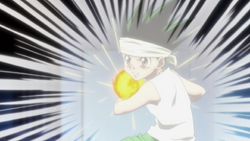
As an Enhancer, Gon can strengthen his fists
If a student increases the quantity of water in the glass during their Water Divination, then that student is an Enhancer (
Enhancement is the most balanced category, allowing users to spread themselves evenly between offense and defense and become very powerful using only simple abilities. Examples of more complex Enhancement abilities include enhancing one's healing factor[29] or boosting the target's growth.[14] However, it is a common belief that Enhancers generally do not need special techniques as their natural category already has the best balance between attack and defense as its primary attribute.[64] This might play into why most Enhancement Nen abilities in the series appear to be mere applications of basic and/or advanced Nen techniques at first glance due to the lack of requirement to manage between pros and cons on an overall scale during their development. Affinity for this category in fact plays a crucial role in combat at all times, even when a Nen ability is not being used.[29]
Notable Enhancers include:
Transmutation
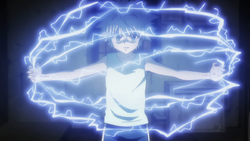
Killua can transmute his aura into electricity
If a student changes the taste of the water in the glass during their Water Divination, then that student is a Transmuter (
Transmuters are not limited to mimicking the properties of solid matter. For example, Killua Zoldyck uses his aura to mimic the properties of electricity.[73] Transmuters can also give their aura certain properties instead of replicating the characteristics of a substance in their entirety: Hisoka's Bungee Gum mimics and combines the properties of rubber and gum, and it is several times more flexible, sticky and durable than the real thing.[100]
Notable Transmuters include:
Emission
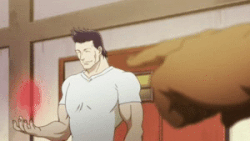
Razor emits a ball of Nen
If a student changes the color of the water in the glass during their Water Divination, then that student is an Emitter (
Due to its properties, Emission is typically employed in abilities with emphasis on range and/or those that have a long-lasting effects. Basic applications include shooting out projectiles or beams of aura at high speed.[5] While this method is primarily used to attack, it can also be used to propel oneself[101] or to cast an effect pertaining to another Nen type remotely.[4] Advanced applications of this Nen category include teleportation[102] and enabling one's aura to phase through non-living matter.[25] Emission has also been combined with music to achieve surprising effects, such as relieving fatigue[72] and transfixing the listeners.[103]
Emitted aura appears to cap the user's output,[104][105] and the more aura is separated from the user's body, the shorter the distance it can travel from the user.[106] In some cases, users have shown the ability to recover emitted aura; thus far, this has only occurred when Manipulation was also involved.[105]
Notable Emitters include:
Conjuration
Kurapika conjures a chain
If a student creates an object in the water in the glass during their Water Divination, then that student is a Conjurer (
Constructs created via Conjuration have a subtle "independence" to them: under certain circumstances, they can continue existing even at a considerable distance from the Conjurer,[107] or even if the Conjurer themselves are not aware that they have yet to be de-materialized.[80] Some Conjurers have also exhibited the capacity to alter the length and size of a materialized item.[108][109] Once a person has mastered the materialization of a certain object, they can conjure it and dispel it in an instant, whenever they want.[110] However, even if one were to completely master this Nen type, there would still be objects they could not materialize, such as swords that can cut anything, as they go beyond "human capacity". Izunavi vaguely described this principle as the inability to conjure objects overly supernatural.[29]
Conjured objects can in fact possess special abilities. For instance, the Phantom Troupe thief, Shizuku, is able to conjure a vacuum cleaner that can infinitely suck up objects, but with the condition that it cannot suck up living things and things made out of Nen.[111] Similar to Manipulation, Conjuration abilities tend to be very specific, complex, and conditional. Conditions can be imbued into conjured objects to make them stronger. Kortopi, for example, is able to materialize a perfect inanimate copy of any object or person that he touches. However, the copies of all objects generated will automatically disappear after 24 hours.[112] By resorting to Limitations, a Conjurer can take their ability a step further and materialize objects with properties that come even closer to exceeding human capacity, although they still cannot surpass it.[29]
Conjuration is the only way in which Nen can create things that non-users can see and touch, unless they are hidden from the senses with In.[79] Alternatively, Conjurers can create abilities whose constructs are invisible to non-users[75] and even specific Nen users,[27] to the point that only one person may be able to perceive them.[113] However, the fewer people are able to see a conjured construct, the lower the risk and the more energy is expended in its creation, resulting in an increased aura cost.[75]
Notable Conjurers include:
Manipulation
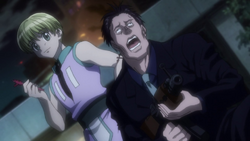
Shalnark uses manipulation abilities to control others
If a student moves the leaf floating on the water in the glass during their Water Divination, then that student is a Manipulator (
Manipulators are the Nen users who can pour the most aura into an object.[79] In many cases they are seen capable of inflicting and maintaining the effects of their abilities from afar, seemingly without the aid of Emission-type Nen, most commonly with the aid of a specific medium.[115][116] The complexity of the orders assigned also depends on the target: sentient beings and machinery can carry out more complex tasks, as opposed to simpler, inanimate objects.[17] Manipulation of the highest class is capable of semi-forcing the Aura Nodes of a non-user to open.[14]
There are multiple types of mind control:
- Soliciting (
要 請 型 , yōsei-gata—lit. "request type") Manipulators leave the free will of the victim intact, but condition them into working in their favor. An example of soliciting-type ability is rewriting the target's memories. An advantage of this type of control is that it can potentially be used on several targets by consuming only a small amount of aura. Halkenburg Hui Guo Rou's Guardian Spirit Beast is presumed to employ this type of Manipulation Nen. - Coercive (
強 制 型 , kyōsei-gata—lit. "compulsion type") Manipulators exert total control over the victim, taking over both their mind and body. - Pseudo-coercive (
半 強 制 型 , han kyōsei-gata—lit. "half compulsion type") Manipulators either take over the body of the victim or trap them into a situation where they have no choice but follow the Manipulator's orders. Momoze Hui Guo Rou's Guardian Spirit Beast employs this type of Manipulation Nen.[7] - The specifics of diffusive induction type (
誘 導 型 , yūdō-gata) Manipulation have yet to be explained in detail. It was described as weakly coercive but capable of influencing a large number of people, which it was seen doing by affecting their emotions towards a certain object. Salé-salé Hui Guo Rou's Guardian Spirit Beast is known to exercise this type of mind control.[102][117]
Notable Manipulators include:
Specialization
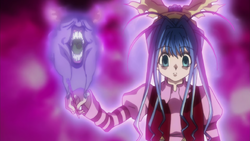
Neon using her fortune telling ability
If a student causes some other effect during their Water Divination, then that student is a Specialist or Special (
It is currently unknown how Specialists develop their Nen abilities. In Neon's case, she obtained an ability that she had been wishing for since she was a child,[121] while Tserriednich manifested his own one week after being initiated to Nen and without trying or even being aware of it.[122] It seems that a Specialist's manifestation of Hatsu during Water Divination reflects their character and may thus give some insight into the general direction in which they might or should develop their ability,[78] since Hatsu is profoundly affected by personality,[123] although the information received this way is vague enough that it is impossible to pin down just what kind of ability a Specialist has already developed through their results during the Water Divination test.[25]
Of the many possible effects that can occur during a Specialist's Water Divination,[5] only three have been shown so far: Neferpitou's aura caused the leaf on top of the water to dry out and crumble;[123] Tserriednich's caused the water to boil and a putrid smell to be released;[78] and Kurapika's caused the water to change colors and the leaf to spin.[25]
Notable Specialists include:
Subcategories of Nen Abilities
Regardless of their type, some Nen abilities share common traits that allow them to be grouped in recognizable subcategories.
Collaborative Type
The exact nature of collaborative type (
Notable users of collaborative type abilities include:
- Tubeppa Hui Guo Rou's Guardian Spirit Beast[46]
Compound Type
The exact nature of compound type (
Notable users of collaborative type abilities include:
- Zhang Lei Hui Guo Rou's Guardian Spirit Beast[78]
Counteractive Type
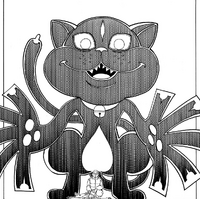
Camilla's retribution on her attacker
Counteractive (迎撃型 counter type—base kanji lit. "interception" or "ambush attack") Nen abilities activate after the user takes damage and return it to the assailant.[33] Since the ability user strikes second, they run more risks, which increases the power of the ability.[46] The greater the damage suffered, the stronger the ensuing counter. The most effective ways to neutralize a counteractive-type Nen user are to incapacitate them without injuring them or to kill them with one blow; however, some of them can even utilize death as an activation condition.[33]
Notable users of counteractive abilities include:
Feitan's Rising Sun[124] also seems to fulfill the criteria of the counteractive type.
Curse
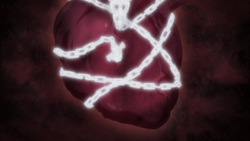
Judgment Chain around a victim's heart
A curse (
Notable curse casters include:
- Kurapika[30]
Abilities with similar effects to Judgment Chain are Genthru's Countdown[125] and Knuckle's Hakoware,[86] and like the former they require an Exorcism to be removed without the caster's consent.
Diffusive Levy Type
Diffusive levy type (
Notable diffusive levy type ability users include:
- Tyson Hui Guo Rou's Guardian Spirit Beast[46]
Double
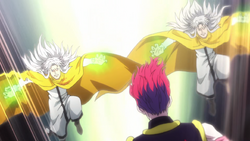
Kastro summons his double
A double or doppelganger[58][13] (分身/ダブル, daburu; ドッペルゲンガー, dopperugengā;[58] or
Notable double users include:
It is unknown whether the Royal Guard Shaiapouf, who has the ability to create copies of himself out of his own cells, could be considered a double user.[126][127]
Exorcism

Abengane's exorcism which uses a wooden effigy
Those who possess the ability to lift curses are called Exorcists (
Notable Exorcists include:
Rihan's Predator shares some affinities with exorcistical abilities, although there are also notable differences[102] which leave it questionable whether it counts as one.
Haunting Type
Haunting type (
Notable users of haunting type abilities include:
- Private Guards of Prince Camilla Hui Guo Rou[131]
Loan Type
Loan type (
Notable users of loan type abilities include:
- Kurapika[14]
Nen Beast
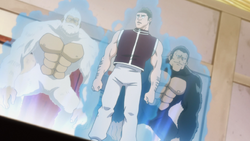
Goreinu summoning his two "Sages"
A Nen beast (
- Increase the number of allies and control them;
- Decrease the number of enemies;
- Steal something from those who are affected by the Nen beast in order to strengthen it or its creator.[102]
It has yet to be confirmed if an animated construct needs to be conjured to be classified as a Nen beast. Morel Mackernasey has shown the ability to produce automated Nen constructs without the need for Conjuration,[85] although they have never been referred to as Nen beasts. It is also unknown whether doubles are considered Nen beasts or a separate subcategory of Nen ability.
Notable users of Nen beasts include:
Depending on how this Nen ability subcategory is defined, Shachmono Tocino,[106] Neon Nostrade,[134] Chrollo Lucilfer (through a stolen ability),[135] Biscuit Krueger,[136] Kite,[137] Morel Mackernasey,[56][85] Knuckle Bine,[86] Neferpitou,[66][31] Flutter,[138] Ikalgo (through a reanimated corpse),[139] Kurapika,[4] Musse,[23] Benjamin Hui Guo Rou (through an inherited ability),[33] Rihan, Yushohi,[117] and Hinrigh Biganduffno[140] might also make use of Nen beasts. Nasubi Hui Guo Rou and his 14 children are all hosts of parasitic Nen beasts, granted to them by an ancestor through the Seed Urn Ceremony.[24]
Parasitic Type
See also: Guardian Spirit Beast
When a Nen user imposes an ability on another person which feeds off that person's aura to manifest its effects, that ability is classified as parasitic (
Notable users of parasitic Nen include:
- The First King of Kakin, who created the Seed Urn[24]
- Momoze Hui Guo Rou's Guardian Spirit Beast[4]
Notable hosts of parasitic Nen include:
- Nasubi Hui Guo Rou[24]
- The 14 Princes of Kakin[24]
Supportive Type
Supportive (
Symbiotic Type
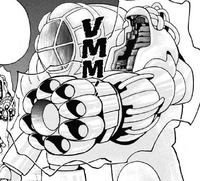
Golem's symbiotic type arm
Some abilities are collaborative in that they require multiple Nen users to donate aura[4] or perform each a different task to be effective. The power of the resulting ability is greater than what the Nen users involved could achieve individually.[141] Such abilities are classified as symbiotic,[46]symbiotic type or joint type (相互協力型;[141] base kanji lit. "mutually cooperative type"; or
Notable joint type Nen users include:
- Golem[141]
- Kurton[4]
- Halkenburg Hui Guo Rou's Guardian Spirit Beast (party form)[46]
- Fugetsu Hui Guo Rou's Guardian Spirit Beast[103]
- Kacho Hui Guo Rou's Guardian Spirit Beast[103]
Tsubone[142] and Morena Prudo[143] may utilize this type of sub-ability as well, the latter in party form. Countdown may also have symbiotic elements in its remote detonation, since, despite it being Genthru's ability, two more people are necessary to activate this aspect of it.[92]
Nen and Risk
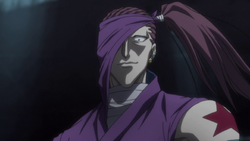
Shoot covers his eye to increase risk
Together with emotion, risk (リスク, risuku) is one of the factors which has a remarkable effect on Nen. Self-imposed stipulations that are harmful or potentially so to the creator, such as willingly limiting the use of their senses, can increase the power of their Nen, and of their Nen abilities in particular.[144] This is because Nen is an expression of willpower, and willingly taking extra risks confirms the Nen user’s resolve.
It is interesting to note that while it is enough to feel certain emotions for them to affect one’s aura, determination becomes a factor only when manifested through the addition of conditions: for example, while Kurapika always had the resolve to fight the Phantom Troupe even at the cost of his life, it was only when he decreed that he would die if he used Chain Jail on someone other than a Spider that he was able to create the ability.[29] The reverse is also true, with restrictions granting greater power to a Nen user even on occasions where they run no risks, such as when Gon charged his Rock to acquire "King White Stag Beetle"[145] and during the dodgeball match against Razor.[146]
Vows and Limitations

Vows and Limitations
Being a product of the mind, Nen responds to the goals, strengths, and desires of individual users. As a result, a student of Nen can increase the overall power of an individual skill by stating a self-imposed restriction that forces even more conditions on it. For example, if one consciously decides something along the lines of "I will only use this skill on Thursdays" or "I will only use this skill against short people" and manages to abide by that rule, that particular skill will become stronger. These restrictions are called "Limitations" (
Unlike normal conditions, which establish the general parameters of an ability, and activation requirements, which determine the circumstances in which said ability can be used, a Limitation can be broken; however, doing so not only entails the loss of the ability it was used on, but it also carries the risk of obliterating one's capacity to use Nen altogether.[29] Limitations that contain some sort of punishment (e.g. "I will die if I break this rule") will strengthen the ability even further.[29] An example is provided by Kurapika, who swore on his own life not to use an ability on anyone but the Phantom Troupe.[108] According to Izunavi, without that added risk, the ability would not have worked.[29]
Conditions
Aside from Vows and Limitations, the creator of a Nen ability can include conditions (
The unconscious of the ability creator plays a fundamental role in determining the exact boundaries of a condition where those boundaries are not rendered explicit. Order Stamp works only on puppets, which are defined as “non-living objects with a discernible head”; vice versa, this means that if the puppet’s head is removed, it ceases to be counted as such and the ability terminates. Additionally, since the creator did not view human corpses as mere objects, despite them otherwise fitting the definition of puppet, Chrollo, who inherited the ability and had no such compunction, was still unable to manipulate corpses via Order Stamp, which however could be used on replicas of corpses.[35]
Activation Requirements
Many Nen abilities can be activated only after fulfilling certain conditions, which are known as activation requirements (発動条件, hatsudō jōken):[149] Shalnark and Illumi are Manipulators who need to stick a specific object into the target to be able to control them,[115][116] whereas Genthru must touch his target while uttering a keyword and then give a proper explanation of all his Nen abilities to activate Countdown.[125] Certain abilities have interchangeable requirements, such as Leol needing to either know the name of the ability he wants to borrow or see it in action,[150] or a photograph being a satisfying replacement for the target of Lovely Ghostwriter if they are not present in person,[119] which increases the user’s chances of success. Activation requirements may also be continuous, meaning that as soon as they are contravened, the connected ability is cancelled (e.g. a puppet controlled with Order Stamp losing its head and thus no longer qualifying as a puppet).[35]
Some activation requirements are common to many, if not all, Nen abilities with similar effects. It is well-known that not any medium can be chosen for Manipulation abilities, but that it must be an object which the user has been using for years[110] and to which they're deeply attached.[17] Likewise, it was estimated that all Nen users who steal Nen abilities and use them for themselves must meet four or five conditions before they can do so,[74] and in general their death causes the restitution of the stolen abilities.[35] An activation requirement can be so common that it is given a name, as is the case for Marking (マーキング), which establishes that a teleportation ability can allow the user only to "jump" (移動 transfer) to a location they had already visited in the past.[149]
Other Conditions
Additional conditions that are unrelated to paying the activation cost of an ability and which limit the range of its potential usages after also exist. The inherent impossibility of breaking such restrictions allows the user to turn them to their advantage: Shizuku’s Blinky is unable to suck in living objects and items created from aura, the latter of which she can exploit to detect traps laid with Nen.[148]
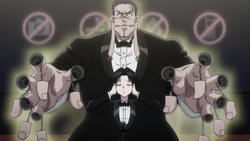
Franklin's severed fingers
Some conditions are deeply tied to the user’s emotion, to the point of being implemented simply because they "feel right".[99][145] Notable examples are Franklin’s severing his own fingers to use his Double Machine Gun[151] and Gon’s chant while preparing a Jajanken attack, increasing risk through a long wind-up and leaving himself unprotected for a few seconds.[86]
There are also conditions that do not regulate the manner in which a Nen ability is to be used, but which impact the user negatively in return for use of the ability. Unlike the penalties that some Limitations contain, they are not activated when a certain rule is broken and do not impair the user’s Nen abilities, but function as a toll of sorts: an instance is Kurapika’s Emperor Time, which shortens his lifespan by one hour for each second it is active.[152]
Loopholes
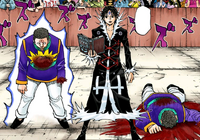
Chrollo using two stolen abilities at the same time
In general, it does not appear to be possible to break a condition; however, there are Nen users who create additional abilities to bypass certain restrictions of others, so as to be capable of circumventing them under very specific circumstances. The most notable instance is Chrollo's creation of his Double Face ability, which enables him to modify the requirements of Skill Hunter that would otherwise prevent him from using more than one stolen ability at a time and from keeping both of his hands free in exchange for the addition of extra Limitations.[59] Likewise, Gon can charge two Jajanken attacks simultaneously thanks to a technique called Round 2,[9][86] although it is not clear whether it is a loophole in Jajanken or a Nen ability proper.
Quantification of Aura
Enhancement and Limitations
Reinforcement Nen plays a crucial part in combat, and as such, one's affinity for said Nen category is a factor of paramount importance. For example, while a skilled Conjurer may be unable to fully block 9mm bullets with Gyo,[19] some master Enhancers can utilize Ten or Ren to resist sniper bullets without a single scratch, as well as to come out of the head-on explosion caused by an anti-tank bazooka with only minor burns.[97] When two Nen users clash, it is possible to make predictions about the outcome through a simple equation. Physical strength is represented by the acronyms AP (Attack Points; アタックポイント) and DP (Defense Points; ディフェンスポイント[inference 🖱]), depending on the action of the Nen user, while the proficiency in Enhancement is expressed in SP (Spirit Points; センスポイント, lit. "Sense Point"). The sum of these two factors indicates the value of one's offensive or defensive capabilities.
If an Enhancer and a Conjurer who possess equal physical strength and who have maximized Nen reinforcement were to clash, and the Enhancer was the one attacking, his attack power would be expressed as:
For the Conjurer, who has the same physical strength but whose proficiency in Enhancement would not exceed 60% even if maximized, his defense power would be:
The equation representing the action is:
Thus the Conjurer would suffer 40% of the damage even if he managed to block the attack correctly. This method is a simplification, since physical strength and aura output differ from person to person, and the location, environment and moment of the attack are fundamental variables in a real fight. Nen itself is much more complicated, since its power varies depending on the user's mental state. Because of this, it is possible to use a Limitation to strengthen one's will and thus one's aura, exceeding the normal limit. If in the same instance as before the Conjurer used a Limitation worth 2 MP (Mystery Points; ミステリーポイント), his defense would become:
As a consequence, the equation would be:
In this case, the Conjurer would be able to block the Enhancer's attack without suffering any damage. However, due to the inherent risks of a Limitation and exceeding one's 100% limit, not all Nen users decide to resort to this method.[29]
Level, Force, and Accuracy
A Nen user's "Level" in a Nen type determines the abilities that Nen user can learn. It could be tentatively defined as one's degree of proficiency in a Nen type which translates in the creation of a specific ability. A Level 10 Conjurer can only master Conjuration abilities that require an amount of skill equal to or lower than Level 10. The Level of one's natural category determines the ceiling for all others, which can be calculated by applying the rule of affinity: a Level 10 Conjurer can master Transmutation abilities only up to Level 8, Enhancement and Manipulation abilities up to Level 6, and Emission abilities up to Level 4, unless he raises his Level in Conjuration by training in it[90] (or by training other types, which would cause his skills, and thus his Level, in Conjuration to increase as well).[92]
However, while said Conjurer could potentially create the same ability as a Level 4 Emitter, his effective output would pale in comparison with the Emitter's. The reason is that the law of acquisition rates applies a second time, making it so the "Accuracy" and "Force" (which have also been translated collectively as "Effectiveness" or "Power") of a Nen ability are proportional to the predisposition of the user for the category the Nen ability requires. As a consequence, if the Level 10 Conjurer and Level 4 Emitter from the example used the same Level 4 Emission ability, the Force and Accuracy of the Conjurer would amount to a measly 40% of the Emitter's, who has 100% affinity, and thus 100% Force and Accuracy, for that type.[90]
Aura Power
Knuckle Bine devised a way to convert aura in a numeric value, and use it in a system similar to the process of finding the Capacity factor of a power plant, in this case the power plant being the Nen user and the energy being the aura. The arbitrary unit of his system corresponds to the approximate amount of aura spent every second by a Nen user in battle mode (1 unit per second), and it is called "aura". However, once the fight starts, the aura consumption increases up to 6 or even 10 aura per second, due to the usage of techniques like Ryu and Ken and of Nen abilities. The less skilled the Nen user and the more powerful the technique, the more aura is consumed this way. Inexperienced users can consume as many as 10 aura per seconds with Ken, with the annexed increase when they utilize advanced techniques. After assessing how much aura his opponents spend in combat every second and for how long they can keep using it, Knuckle is able to estimate the total amount of aura they can access. He uses three parameters:
Knuckle explains his concept of MAP
- Maximum Aura Power or M.A.P. (最大オーラ量 or MOP):[note 9] the amount of aura stored inside the body of a Nen user. It varies for each individual and can be increased through training.
- Potential Aura Power or P.A.P. (潜在オーラ量 or POP):[note 9] the amount of aura that a Nen user can expend before passing out. It appears to correspond to how much of their M.A.P. a Nen user can access at a specific point in time.
AAP and PAP
- Actual Aura Power or A.A.P. (顕在オーラ量 or AOP):[note 9] the quantity of aura that is used effectively at any moment; in other words, aura output. This is what determines the efficiency of the Nen user in a combat situation, as a high P.A.P. with a low A.A.P. is meaningless. A.A.P. can be increased through training. It is also influenced by how well an individual can use Nen: lack of practice or low affinity for a certain Nen category can cause the power of an attack to be lower than the aura units expended. For example, when Gon used his Round 2 technique against Knuckle, he consumed 4000 aura to charge two abilities, Jajanken: Rock and Jajanken: Paper; however, the actual force of the Emission attack was equivalent only to 500 aura, 25% of the power of Jajanken: Rock and 12.5% of the aura consumed overall.[86]
Training Exercises
Orthodox Nen training[23] begins with meditation exercises,[51] which are aimed at allowing the student to gradually become aware of their aura flow even before their Aura Nodes are opened and to start to control it.[8] In Shingen-ryu kung fu, the Ten step in the Nen of the Flame is also utilized as a way for the student to polish their mind and thus the flow of their Ten.[28]
The first meditation exercise[51] has the aim of ascertaining the student's natural potential. The student is required to put their index fingers slightly apart, and have the tips close in on each other until they have the sensation of pushing against something. The farther apart the fingertips are when the student begins to feel the presence of aura, the greater their predisposition.[19] What follows are the basics of aura manipulation, even if the student is still incapable of seeing aura. In the first and only known exercise of this phase, the student is to place their hands in front of their chest and imagine forming a ball between them. This exercise is meant to develop the student's ability to feel their own aura. In general, it is performed for 10 days, with 3 sets of 10 minutes every day; particularly talented individuals can begin to sense their aura in 5 to 7 days, although in extremely rare cases some may succeed on the first try.[23]
Students generally learn to open the Aura Nodes in their eyes, thus obtaining the ability to see aura, in about one year,[27] although gifted individuals can grasp the basics of Nen in six months.[13] Once all of the student's nodes are opened, which normally occurs after one year of three hours of basic exercises every day,[14] they are introduced to the first principle, Ten,[28] learning to contain the leaking aura little by little through breathing exercises.[14] Next is Ren, which in turn leads to Gyo and other techniques.[28] Hatsu is first trained through the Water Divination exercise, by having the student attempt to produce a more pronounced change.[5]
Mastering Ten in six months is indicative of uncommon talent.[8] Regardless of their level, it is advised Nen practitioners train their Ten and Ren daily,[64] since they are the foundations of all advanced techniques.[28]
Biscuit's Training
Biscuit has devised exercises to train her students in every aspect of Nen after they master the basic techniques enough to pass the secret Hunter Exam. She models her coaching method on her students to best suit their needs, often giving them very precise instructions but also letting them reach the answer on their own from time to time. Unlike her former pupil Wing, she has her students train their guard and physical, combat and analytical abilities together with Nen. By her own admission, her regimen is much harder than his.[153]
Gyo Training
The first exercise she has her students perform requires them to rapidly activate Gyo on their eyes and tell her what number she is forming with her In-concealed aura whenever she raises her index finger. Should she have more than one student, she makes them compete amongst each other, and the slower one to respond is penalized with physical exercises.[154] Should all her students be too slow, all of them will be punished.[18] There is no set time for this exercise, and in fact it is used to teach students to remain constantly vigilant and activate Gyo at the slightest hint of danger, until it becomes second nature to them.[154]
Shu Training
On Greed Island, Biscuit had Gon and Killua dig through rock formations using regular shovels, confiding that they'd be able to figure out the existence of the technique and how to utilize it all on their own.[18]
Ken Training
After explaining how to perform Ken, Biscuit proceeds to demonstrate Ko and demands that her students maintain Ken for at least thirty minutes, during which she holds Ko as if about to strike.[16] Once they manage to hold the technique for that long, she hits them with a slow-moving Ko punch to test their resistance.[87]
Ryu Training
When a student manages to hold Ken for at least 30 minutes, they are ready to learn Ryu. Biscuit instructs them on which proportions of their aura to focus on which body part for 30 minutes, three times a day. At the same time, her student are introduced to the kumite section of her program, in which they spar using Ryu, so as to learn how to adjust their aura flow while attacking and defending.[87]
Ko Training
Biscuit's exercises or Ko training were not shown, but it appears the technique is taught at some point after the Ken exercises[16] and before the Nen type ones, as the first of the latter requires the use of Ko.[76]
Nen Type Training
See also: Biscuit's Nen Type Training
These exercises are structured in levels, and the student can generally progress to the next after achieving a certain degree of mastery over a lower one. Her students train in all accessible Nen types, as, on top of granting them more flexibility, this allows them to progress in their own category more quickly.[92] Her fundamental rule is that only one Nen category can be trained a day.[76] Students normally focus on their natural category every other day, while in the other Nen types are rotated and more are added as the student progresses.[99] When coaching Gon and Killua, Biscuit introduced them to Enhancement first,[76] and seemingly saved Manipulation for last.[99]
Enhancement Training
- Level 1 - Rock Breaking
The student enhances a stone's durability using Shu and Ko to repeatedly smash other rocks without breaking the one they are holding. The exercise terminates either when a student manages to break 1000 rocks in a day, in which case they are ready for the next level, or when the stone they are holding shatters. On top of the aura consumption, the repetitive movement puts stress on the student's focus, causing their aura control to become less and less precise. Only one try a day is allowed.[76]
Transmutation Training
- Level 1 - Shape-shifting
The student must form the numbers 0 through 9 on top of their finger by manipulating the shape of their aura, much like Biscuit does to train their Gyo, while also running. The student can proceed to the next level once they manage to form the 10 numbers in one minute, with the end goal being 5 seconds.[99]
Emission Training
- Level 1 - Name Unknown
This exercise is comprised of two parts. In the first, the student must form a small bubble out of their aura from the tip of their finger and maintain it in place for one minute. Once they manage to do so, they have to attempt to throw it over a certain distance without the bubble dissipating. The time the aura bubble can be maintained afloat reflects the strength of one's Ten. Effort is also required to maintain the shape of the bubble.[65]
- Level 5 - Floating Hand[136]
The student positions into a one arm handstand, then they project their aura outwards explosively from the hand that is touching the ground so as to propel themselves into the air. The student can proceed to the next level once they manage to launch themselves a few dozen centimeters; otherwise, they keep practicing for as long as they can maintain the handstand. A student who has mastered this level is able to knock an opponent back a dozen feet with an Emission attack.[136]
Ren Training
Very similar to the basics of Ken training, this step of Biscuit's regimen is intended to increase the student's aura pool, in particular to allow them to maintain Ken for longer in combat. In order to accelerate progress, she can speed up the student's recovery with her Nen ability.[69] Once the student manages to maintain Ren for three hours, they will still have to hold it for that amount of time once a day. Biscuit also had Gon and Killua fight Knuckle right after the end of the exercise.[56]
Kurapika's Training
According to Kurapika, the way a person feels most comfortable clasping their hands together can hold information about the best way to introduce them to the basics of Nen. There are at three groups:
- Those who touch their palms together and interlock their fingers as if in prayer are called "prayers" (
祈り 型 , purei-gata—lit. "pray-type"). The first exercise for them is to imagine scooping up water with their eyes closed. - Those who grasp their hands like during a handshake are named "shakers" (
握手 型 , sheiku-gata—lit. "shake-type"). The first exercise requires them to hold hands in a circle and to imagine their aura flowing clockwise. - Those who grasp their wrist are called "catchers" (
片手主導 型 , kyatchi-gata—lit. "catch-type"). The first exercise requires them to spin their hands in a circle as if to make cotton candy.[75]
With this method it is supposedly possible to learn to generate enough aura to perform the Water Divination test after only one week of training;[25] in reality, however, none of Kurapika's students performed their first Water Divination with their own aura, as they had their Aura Nodes semi-forced open by his Nen ability. Kurapika implied to Hashito that his training is what prevented his students from depleting their aura reserves after being "initiated", which would mean that its purpose was to introduce his students to the basics of aura manipulation.[14]
The first step for a Conjurer to develop a Nen ability is to decide what object they want to materialize. Then, they must undergo intense imagery training by being in contact with said object every waking moment, studying them with all five senses and drawing pictures of them. When the student begins to dream about the intended object every time, the teacher takes it away from them. The dreams are subsequently replaced by hallucinations, which get more and more real to the point they also involve the senses of touch and hearing, until the Conjurer unwittingly materializes one.[64]
Trivia
- In the manga, six characters have used Nen before it was explained to Gon and Killua: Gon,[17] Illumi[155][156][157] (Hunter Exam arc), Zebro[158] (Zoldyck Family arc), Zushi, Wing,[159][2] and Hisoka[3] (Heavens Arena arc).
- Kurapika is the only character who falls under two different Nen categories.
- Manipulation is the only category of Nen that none of the protagonists fall under.
- Aura can be filmed,[28][71] but it will still remain invisible to those who cannot use Nen.[160]
- Curiously, despite sound having very different physical properties from light and thus hearing differing from sight, non-users are unable to hear sounds made by Nen constructs.[4]
- According to Hisoka, Enhancers and Transmuters have opposite personalities, and they might be attracted to each other because of it. There are several instances of this happening in the series:
- Gon and Killua: They are best friends.
- Gon and Hisoka: Hisoka is attracted to and fond of Gon, and has aided (or refrained from harming and/or killing) him on numerous occasions, although the interest is not reciprocated.
- Phinks and Feitan.
- Netero and Zeno: According to the latter, they are like "Yang" and "Yin" respectively.
- It is interesting to note that there is some enmity between Transmuters and Enhancers in the series. For example, the Enhancers Uvogin, Phinks, and Nobunaga didn't get along well with Hisoka, a Transmuter.
- While using Ken, Gon's aura output during his final fight against Knuckle was about 1800 aura units, and a punch thrown in that state 150 aura units.[86] This might mean that on average, a Ken punch contains 1/12th of the user's total aura output.
- A similar calculation may be used to determine a relation between aura output and aura reserves. If Gon's M.A.P. (21,500 aura units) is divided by his output (1800 aura units), the result is approximately 12. However, output is a factor that can vary with training,[86] and Gon's has always been considered exceptional.[161] Furthermore, it used to fluctuate with his emotions.[162] All of this suggests that his values may not be reliable to establish a general law.
- The terms used for "Vows" and "Limitations" are homophones in Japanese (せいやく, Seiyaku).
Anime and Manga Differences
The equation according to the anime
- In the 2011 anime, the equation representing the power of Limitations is different from its counterpart in the manga, with Mystery Points affecting both Attack Points and Spirit Points:[163]
Intertextuality and References
- The Water Divination Aura Screening may have been loosely inspired by the concept of hydromancy (a.k.a. "water-divination")—a method of divination by means of water, including the interpretation of color, ebb, and flow, or ripples produced in perturbed water.
Miscellaneous
- Aura is translated as "Chi" (氣) in the Chinese edition of Hunter × Hunter. Chi is known as "Ki" (気) in Japanese.
Translations around the World
| Language | Name | |
|---|---|---|
| نين (Nayn) | ||
| 念能力 (Niàn Nénglì) | ||
| Нэн (Nen) | ||
References
- ↑ Hunter × Hunter - Volume 9, Chapter 80
- ↑ 2.0 2.1 2.2 2.3 2.4 2.5 Hunter × Hunter - Volume 6, Chapter 46
- ↑ 3.0 3.1 3.2 3.3 3.4 3.5 3.6 3.7 3.8 3.9 Hunter × Hunter - Volume 6, Chapter 47
- ↑ 4.0 4.1 4.2 4.3 4.4 4.5 4.6 4.7 4.8 Hunter × Hunter - Volume 35, Chapter 361
- ↑ 5.00 5.01 5.02 5.03 5.04 5.05 5.06 5.07 5.08 5.09 5.10 5.11 5.12 5.13 5.14 5.15 5.16 5.17 5.18 5.19 5.20 5.21 5.22 5.23 5.24 5.25 Hunter × Hunter - Volume 7, Chapter 60
- ↑ 6.0 6.1 Hunter × Hunter - Volume 36, Chapter 377
- ↑ 7.0 7.1 7.2 7.3 7.4 7.5 Hunter × Hunter - Volume 36, Chapter 372
- ↑ 8.00 8.01 8.02 8.03 8.04 8.05 8.06 8.07 8.08 8.09 8.10 8.11 8.12 8.13 8.14 8.15 Hunter × Hunter - Volume 6, Chapter 48
- ↑ 9.0 9.1 Hunter × Hunter - Volume 20, Chapter 209
- ↑ Hunter × Hunter - Volume 34, Chapter 356
- ↑ Hunter × Hunter - Volume 21, Chapter 215
- ↑ Hunter × Hunter - Volume 31, Chapter 326
- ↑ 13.0 13.1 13.2 13.3 13.4 13.5 Hunter × Hunter - Volume 35, Chapter 368
- ↑ 14.00 14.01 14.02 14.03 14.04 14.05 14.06 14.07 14.08 14.09 14.10 14.11 14.12 Hunter × Hunter, Chapter 388
- ↑ Hunter × Hunter - Volume 14, Chapter 139
- ↑ 16.0 16.1 16.2 16.3 16.4 16.5 16.6 16.7 16.8 Hunter × Hunter - Volume 15, Chapter 141
- ↑ 17.0 17.1 17.2 17.3 17.4 17.5 17.6 17.7 17.8 Hunter × Hunter - Volume 6, Chapter 50
- ↑ 18.0 18.1 18.2 18.3 18.4 Hunter × Hunter - Volume 15, Chapter 140
- ↑ 19.0 19.1 19.2 19.3 19.4 19.5 19.6 Hunter × Hunter - Volume 35, Chapter 370
- ↑ Hunter × Hunter - Volume 2, Chapter 9
- ↑ Hunter × Hunter - Volume 13, Chapter 122
- ↑ Hunter × Hunter - Volume 23, Chapter 242
- ↑ 23.0 23.1 23.2 23.3 23.4 Hunter × Hunter - Volume 35, Chapter 366
- ↑ 24.0 24.1 24.2 24.3 24.4 24.5 Hunter × Hunter - Volume 33, Chapter 349
- ↑ 25.0 25.1 25.2 25.3 25.4 25.5 Hunter × Hunter, Chapter 386
- ↑ 26.0 26.1 Hunter × Hunter - Volume 6, Chapter 54
- ↑ 27.0 27.1 27.2 27.3 Hunter × Hunter - Volume 35, Chapter 362
- ↑ 28.00 28.01 28.02 28.03 28.04 28.05 28.06 28.07 28.08 28.09 28.10 28.11 28.12 28.13 28.14 28.15 28.16 Hunter × Hunter - Volume 7, Chapter 56
- ↑ 29.00 29.01 29.02 29.03 29.04 29.05 29.06 29.07 29.08 29.09 29.10 29.11 29.12 29.13 29.14 29.15 29.16 Hunter × Hunter - Volume 9, Chapter 83
- ↑ 30.0 30.1 30.2 30.3 Hunter × Hunter - Volume 13, Chapter 120
- ↑ 31.0 31.1 Hunter × Hunter - Volume 29, Chapter 306
- ↑ 32.0 32.1 Hunter × Hunter - Volume 34, Chapter 357
- ↑ 33.0 33.1 33.2 33.3 33.4 33.5 Hunter × Hunter - Volume 36, Chapter 373
- ↑ Hunter × Hunter - Volume 34, Chapter 354
- ↑ 35.0 35.1 35.2 35.3 Hunter × Hunter - Volume 34, Chapter 352
- ↑ 36.0 36.1 Hunter × Hunter - Volume 22, Chapter 225
- ↑ Hunter × Hunter - Volume 19, Chapter 191
- ↑ Hunter × Hunter - Volume 22, Chapter 233
- ↑ 39.0 39.1 Hunter × Hunter - Volume 18, Chapter 186
- ↑ 40.0 40.1 Hunter × Hunter - Volume 19, Chapter 190
- ↑ 41.0 41.1 Hunter × Hunter - Volume 19, Chapter 197
- ↑ 42.0 42.1 Hunter × Hunter - Volume 21, Chapter 216
- ↑ Hunter × Hunter - Volume 25, Chapter 266
- ↑ Hunter × Hunter - Volume 29, Chapter 333
- ↑ Hunter × Hunter - Volume 29, Chapter 334
- ↑ 46.00 46.01 46.02 46.03 46.04 46.05 46.06 46.07 46.08 46.09 46.10 Hunter × Hunter - Volume 36, Chapter 375
- ↑ Hunter × Hunter - Volume 16, Chapter 160
- ↑ Hunter × Hunter - Volume 8, Chapter 65
- ↑ Hunter × Hunter - Volume 33, Chapter 342
- ↑ Hunter × Hunter - Volume 36, Chapter 380
- ↑ 51.0 51.1 51.2 Hunter × Hunter - Volume 35, Chapter 363
- ↑ Hunter × Hunter - Volume 29, Chapter 331
- ↑ Hunter × Hunter - Volume 6, Chapter 51
- ↑ Hunter × Hunter - Volume 34, Chapter 359
- ↑ Hunter × Hunter - Volume 30, Chapter 320
- ↑ 56.0 56.1 56.2 Hunter × Hunter - Volume 20, Chapter 202
- ↑ 57.0 57.1 57.2 57.3 57.4 Hunter × Hunter - Volume 7, Chapter 62
- ↑ 58.0 58.1 58.2 58.3 Hunter × Hunter - Volume 6, Chapter 53
- ↑ 59.0 59.1 59.2 Hunter × Hunter - Volume 34, Chapter 351
- ↑ 60.0 60.1 60.2 60.3 Hunter × Hunter - Volume 10, Chapter 85
- ↑ Hunter × Hunter - Volume 10, Chapter 86
- ↑ Hunter × Hunter - Volume 10, Chapter 87
- ↑ Hunter × Hunter - Volume 24, Chapter 257
- ↑ 64.0 64.1 64.2 64.3 64.4 64.5 Hunter × Hunter - Volume 13, Chapter 123
- ↑ 65.0 65.1 65.2 Hunter × Hunter - Volume 15, Chapter 148
- ↑ 66.0 66.1 Hunter × Hunter - Volume 21, Chapter 222
- ↑ 67.0 67.1 Hunter × Hunter - Volume 10, Chapter 90
- ↑ Hunter × Hunter - Volume 6, Chapter 52
- ↑ 69.0 69.1 Hunter × Hunter - Volume 20, Chapter 201
- ↑ Hunter × Hunter - Volume 7, Chapter 58
- ↑ 71.0 71.1 Hunter × Hunter - Volume 7, Chapter 57
- ↑ 72.0 72.1 Hunter × Hunter - Volume 13, Chapter 121
- ↑ 73.0 73.1 Hunter × Hunter - Volume 13, Chapter 125
- ↑ 74.0 74.1 74.2 74.3 74.4 Hunter × Hunter - Volume 11, Chapter 98
- ↑ 75.0 75.1 75.2 75.3 75.4 Hunter × Hunter - Volume 36, Chapter 371
- ↑ 76.0 76.1 76.2 76.3 76.4 76.5 Hunter × Hunter - Volume 15, Chapter 145
- ↑ 77.0 77.1 77.2 Hunter × Hunter - Volume 13, Chapter 124 Cite error: Invalid
<ref>tag; name "chap124" defined multiple times with different content - ↑ 78.0 78.1 78.2 78.3 78.4 78.5 Hunter × Hunter, Chapter 376
- ↑ 79.0 79.1 79.2 79.3 Hunter × Hunter - Volume 9, Chapter 82
- ↑ 80.0 80.1 80.2 Hunter × Hunter - Volume 7, Chapter 55
- ↑ 81.0 81.1 81.2 Hunter × Hunter - Volume 11, Chapter 94
- ↑ Hunter × Hunter - Volume 23, Chapter 237
- ↑ Hunter × Hunter - Volume 29, Chapter 308
- ↑ 84.0 84.1 Hunter × Hunter - Volume 24, Chapter 259
- ↑ 85.0 85.1 85.2 Hunter × Hunter - Volume 23, Chapter 244
- ↑ 86.0 86.1 86.2 86.3 86.4 86.5 86.6 86.7 Hunter × Hunter - Volume 20, Chapter 211
- ↑ 87.0 87.1 87.2 87.3 Hunter × Hunter - Volume 15, Chapter 142
- ↑ 88.0 88.1 Hunter × Hunter - Volume 20, Chapter 206
- ↑ Hunter × Hunter - Volume 20, Chapter 210
- ↑ 90.0 90.1 90.2 90.3 90.4 Hunter × Hunter - Volume 12, Chapter 108
- ↑ Hunter × Hunter - Volume 7, page 126 [Extra content.]
- ↑ 92.0 92.1 92.2 92.3 Hunter × Hunter - Volume 15, Chapter 144
- ↑ 93.0 93.1 93.2 93.3 93.4 93.5 93.6 Hunter × Hunter - Omnibus Version: Treasure [?] (pg. 492
 )
)
- ↑ 94.0 94.1 94.2 94.3 Hunter × Hunter - Volume 7, Chapter 63
- ↑ Hunter × Hunter - Episode 36 (2011)
- ↑ 96.0 96.1 Hunter × Hunter - Volume 35, Chapter 369
- ↑ 97.0 97.1 Hunter × Hunter - Volume 9, Chapter 75
- ↑ Hunter × Hunter - Volume 9, Chapter 79
- ↑ 99.0 99.1 99.2 99.3 99.4 Hunter × Hunter - Volume 15, Chapter 146
- ↑ Hunter × Hunter - Volume 31, Chapter 327
- ↑ Hunter × Hunter - Volume 7, Chapter 59
- ↑ 102.0 102.1 102.2 102.3 102.4 Hunter × Hunter, Chapter 374
- ↑ 103.0 103.1 103.2 Hunter × Hunter - Volume 34, Chapter 383
- ↑ 104.0 104.1 Hunter × Hunter - Volume 17, Chapter 166
- ↑ 105.0 105.1 Hunter × Hunter - Volume 23, Chapter 245
- ↑ 106.0 106.1 Hunter × Hunter - Volume 8, Chapter 68
- ↑ Hunter × Hunter - Volume 12, Chapter 109
- ↑ 108.0 108.1 Hunter × Hunter - Volume 9, Chapter 77
- ↑ Hunter × Hunter - Volume 31, Chapter 321
- ↑ 110.0 110.1 Hunter × Hunter - Volume 12, Chapter 106
- ↑ Hunter × Hunter - Volume 8, Chapter 73
- ↑ Hunter × Hunter - Volume 11, Chapter 103
- ↑ 113.0 113.1 113.2 113.3 Hunter × Hunter - Volume 34, Chapter 360
- ↑ Hunter × Hunter - Volume 22, Chapter 226
- ↑ 115.0 115.1 Hunter × Hunter - Volume 11, Chapter 102
- ↑ 116.0 116.1 Hunter × Hunter - Volume 31, Chapter 328
- ↑ 117.0 117.1 Hunter × Hunter, Chapter 381
- ↑ Hunter × Hunter - Volume 12, Chapter 105
- ↑ 119.0 119.1 Hunter × Hunter - Volume 12, Chapter 110
- ↑ Hunter × Hunter - Volume 23, Chapter 243
- ↑ Hunter × Hunter - Volume 11, Chapter 96
- ↑ 122.0 122.1 Hunter × Hunter - Chapter 384
- ↑ 123.0 123.1 Hunter × Hunter - Volume 19, Chapter 198
- ↑ Hunter × Hunter - Volume 22, Chapter 229
- ↑ 125.0 125.1 Hunter × Hunter - Volume 15, Chapter 143
- ↑ Hunter × Hunter - Volume 27, Chapter 284
- ↑ Hunter × Hunter - Volume 27, Chapter 286
- ↑ 128.0 128.1 Hunter × Hunter - Volume 31, Chapter 325
- ↑ 129.0 129.1 129.2 129.3 Hunter × Hunter - Volume 15, Chapter 147
- ↑ 130.0 130.1 Hunter × Hunter - Volume 25, Chapter 261
- ↑ 131.0 131.1 131.2 Hunter × Hunter, Chapter 389
- ↑ 132.0 132.1 Hunter × Hunter - Volume 16, Chapter 162
- ↑ Hunter × Hunter - Volume 17, Chapter 164
- ↑ Hunter × Hunter - Volume 8, Chapter 71
- ↑ Hunter × Hunter - Volume 11, Chapter 97
- ↑ 136.0 136.1 136.2 Hunter × Hunter - Volume 17, Chapter 171
- ↑ Hunter × Hunter - Volume 19, Chapter 194
- ↑ Hunter × Hunter - Volume 23, Chapter 246
- ↑ Hunter × Hunter - Volume 26, Chapter 273
- ↑ Hunter × Hunter, Chapter 390
- ↑ 141.0 141.1 141.2 141.3 Hunter × Hunter - Volume 33, Chapter 347
- ↑ Hunter × Hunter - Volume 31, Chapter 329
- ↑ Hunter × Hunter - Volume 36, Chapter 378
- ↑ Hunter × Hunter - Volume 24, Chapter 254
- ↑ 145.0 145.1 Hunter × Hunter - Volume 15, Chapter 150
- ↑ Hunter × Hunter - Volume 17, Chapter 165
- ↑ Hunter × Hunter - Volume 10, Chapter 84
- ↑ 148.0 148.1 Hunter × Hunter - Volume 14, Chapter 134
- ↑ 149.0 149.1 Hunter × Hunter - Volume 36, Chapter 379
- ↑ Hunter × Hunter - Volume 24, Chapter 248
- ↑ Hunter × Hunter - Volume 9, Chapter 76
- ↑ Hunter × Hunter - Volume 35, Chapter 364
- ↑ Hunter × Hunter - Volume 14, Chapter 138
- ↑ 154.0 154.1 Hunter × Hunter - Volume 14, Chapter 136
- ↑ Hunter × Hunter - Volume 3, Chapter 26
- ↑ Hunter × Hunter - Volume 4, Chapter 35
- ↑ Hunter × Hunter - Volume 5, Chapter 36
- ↑ Hunter × Hunter - Volume 5, Chapter 39
- ↑ Hunter × Hunter - Volume 6, Chapter 45
- ↑ Hunter × Hunter - Volume 21, Chapter 223
- ↑ Hunter × Hunter - Volume 17, Chapter 167
- ↑ Hunter × Hunter - Volume 20, Chapter 207
- ↑ Hunter × Hunter - Episode 47 (2011)
Notes
- ↑ In Chapter 388 Kurapika commended Maor for the rate of his progression in spite of his age, but this might have been only a way to flatter him, as he had already done so in the past. If, however, there is truth to it, then age would indeed determine to how quickly one can learn, but not necessarily the degree of proficiency they can reach.
- ↑ "Nen of the Flame" is an unofficial name given to this more theoretical discipline to reflect the difference in the kanji used for it and for Nen proper.
- ↑ Gon and Hisoka, Hunters both, were able to participate in matches and use Nen abilities despite being Hunters, with no warning or ill consequences. In Chapter 62 Hisoka even openly mentions the six Nen categories.
- ↑ Although the term "Hatsu ability" is popular in the English-speaking fandom, that combination of terms was never used in the source material.
- ↑ 5.0 5.1 Despite Izunavi stating the position of Specialization in the Nen chart is due to the fact that Conjurers and Manipulators have the highest chance of becoming Specialists later in life (Chapter 83), it has been shown multiple times that the presence of this Nen type affects all others: for example, Conjurers have 60% affinity for Manipulation instead of 80% because Specialization is located between the two in the chart (Chapters 83 and 108).
- ↑ The Water Divination is also referred as Water Divination Aura Screening (
水 見 式 オーラ 選 別 法 , Mizumishiki Ōra Senbetsu-hō—lit. "Water Divination Aura Sorting Method").[91] - ↑ Kastro is a double user as indicated by one of the terms (in kanji: 分身, bunshin) used to describe his ability to make a copy of himself; the same word is used later to describe other characters with the same type of ability, the only difference being that in the original Japanese text the furigana appears different.
- ↑ The original version of Chapter 166 explicitly mentions "Razor's Nen beasts" (レイザーの 念獣が), whereas the Viz translation refers to them as "conjured goons" (without the chapter suggesting Conjuration was used).
- ↑ 9.0 9.1 9.2 In Japanese, the acronyms MAP, PAP, and AAP were written as MOP, POP, and AOP due to the katakana transcription of "Aura", which is "オーラ", or, in rōmaji, "Ōra". To preserve the original acronym, Viz excluded "Aura" from them in the translation, with the "O" standing for "Output". Furthermore, the "P" in all three acronyms stands for "Power", but the kanji "量" actually means "volume".








